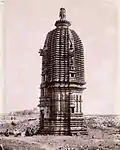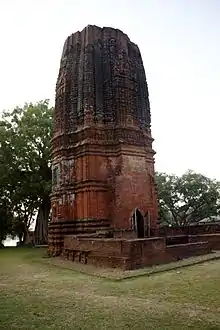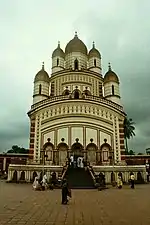Jatar Deul
Jatar Deul also called tower temple (rekha-deul), is located in the numerous rivers criss-crossed by stone-free alluvial and bush landscape of the southern Sundarbans settlements in the Indian state of West Bengal. It belongs to a small sub-group of Bengal temples, the architectural suggestions from Odisha can be traced back.[1][2]
| Jatar Deul | |
|---|---|
 | |
| Religion | |
| Affiliation | Hinduism |
| Deity | Shiva |
| Location | |
| Location | Kankan Dighi/Jata South 24 Parganas |
| State | West Bengal |
| Country | India |
 Location in West Bengal  Jatar Deul (India) | |
| Geographic coordinates | 21°59′33″N 88°29′15″E |
| Architecture | |
| Type | Rekha deul |
| Completed | 11th century |
| Elevation | 30 m (98 ft) |
Geography
| Cities and towns in the eastern part of Diamond Harbour subdivision (including Magrahat I & II, Mandirbazar, Mathurapur I & II CD blocks) in South 24 Parganas district M: municipal city/ town, CT: census town, R: rural/ urban centre, N: neighbourhood, T: religious centre Owing to space constraints in the small map, the actual locations in a larger map may vary slightly |
Location
The Jatar-Deul stands isolated on a small hill in the surroundings of the locality Kanakan Dighi, about 5 km east of the small town of Raidighi in the Mathurapur II community development block in the Diamond Harbour subdivision of the district of South 24 Parganas in West Bengal; whether it is in the vicinity of the temple, formerly a village has given, or whether it is a regional pilgrimage center, is unclear.[3]
Note: The map alongside presents some of the notable locations in the subdivision. All places marked in the map are linked in the larger full screen map.
History
On the client, and thus also on the emergence time of the temple, nothing is known. Some of the researchers – due to a in the vicinity of the discovered copper plate with an inscription from the 10th century. Century, not, however, refers to the temple, or a simultaneous emergence of time adopted; others date it much later, and put the construction into the 17th. or 18. Century.[4]The Archaeolgical Department board at the temple site places establishment around 11th century.[5]
Consecration

There is neither a cult nor any other sculptural or inscriptional evidence available, it is also the consecration of the temple is unclear – some believe it was originally for a Buddhist structure; others see it as a building in honor of the Hindu God Shiva (Mahadev), whose colorful image, and other religious BRIC-a-brac today, the interior of the Cella (garbhagriha) to decorate.[1]
Architecture
The only one about 30 m high tower (rekha-deul) with an internal approximately 3.10 m × 3.10 m mass, increased lying, but windowless cella existing brick temple stands on a square base of about 9,30 × 9,30 m. Noteworthy are the rekha-deul usual steep proportions, the several cornices on the high ogival portal and vertical gradations in the upper part somewhat alleviated by be. A dome-shaped curvature of the construction developed only in the last meters.[1]
According to the List of Monuments of National Importance in West Bengal Jatar Deul is a monument of national importance.[6]
Fair
A fair is held and a horse race is organised on 2nd Baisakh (mid April) every year near the temple.[5]
Photos of Rekha-Deul temples in West Bengal
 Stone Temple of Para, Para, Purulia district
Stone Temple of Para, Para, Purulia district Panchanana Temple near Barakar, Paschim Bardhaman district
Panchanana Temple near Barakar, Paschim Bardhaman district.jpg.webp) Ichhai Ghosher Deul, Gourangapur, Paschim Bardhaman district
Ichhai Ghosher Deul, Gourangapur, Paschim Bardhaman district Siddheshwar Temple, Bahulara, Bankura district
Siddheshwar Temple, Bahulara, Bankura district Temple, Banda, Purulia district
Temple, Banda, Purulia district Pratapeswar-Temple, Kalna, Purba Bardhaman district
Pratapeswar-Temple, Kalna, Purba Bardhaman district
References
- Ghosh, Binoy, Paschim Banger Sanskriti, (in Bengali), part III, 1980 edition, pages 152-155, Prakash Bhaban, Kolkata
- Amit Guha, Classification of Terracotta Temples, archived from the original on 31 January 2016, retrieved 30 September 2019
- "Architecture". Banglapedia. Retrieved 30 September 2019.
- "Architecture". Banglapedia. Retrieved 30 September 2019.
- "Jatar Deul History Unexplained". Tale of 2 Backpackers. Retrieved 10 January 2020.
- "List of Ancient Monuments and Archaeological Sites and Remains of West Bengal - Archaeological Survey of India". Item no. 6. ASI. Retrieved 25 January 2020.
